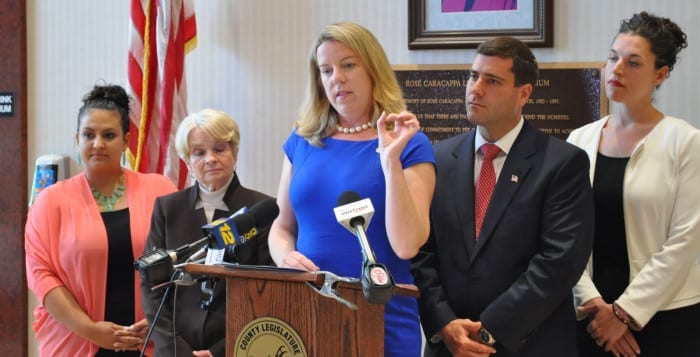Seven candidates vying for three seats on the Northport-East Northport school board in next week’s election got together to talk about pressing issues and field questions from the PTA Council and district residents in a forum on Tuesday evening.
Hot topics included dealing with declining enrollment, maintaining the district’s facilities and grounds, deciding what kind of relationship should exist between a school board and its superintendent, and determining the level of programs the district should offer.
It was a packed room at the Northport High School library, where the lineup of candidates included incumbents Stephen Waldenburg Jr. and David Badanes; newcomers Peter Mainetti, Josh Muno, David Stein and Michael Brunone; and former school board member Tammie Topel.
Declining enrollment is an issue facing not only Northport-East Northport; districts across Long Island are also facing the trend. Candidates had differing opinions on how to address declining enrollment, particularly when it came to consolidating programs.
Topel said it wouldn’t be necessary to cut any programs that have enough students in them. Waldenburg said the numbers “bode for scary times” and the district may need to consider closing schools. Badanes said he wanted to approach the issue from the mind-set of maintaining instead of cutting and said that the enrollment numbers projecting declines could be wrong. Brunone said the district needs to look at its fixed costs.
Mainetti, Muno and Stein said they were in favor of keeping the current programming level intact. Stein said the district needs to stop cutting its programs.
“We have to make ourselves the most competitive,” he said.
Most candidates said they’d be in favor of floating a bond to pay for maintenance and repairs to the district’s buildings and grounds. Mainetti said he’s not a huge fan of bond issues, but it would be good to involve the community if one goes forward. Topel, however, said she wouldn’t support a bond because she’s “not sure the community would go for it.”
The candidates also weighed in on what to do about pending litigation by the Long Island Power Authority, challenging the value of the Northport power plant. The utility has maintained that it’s grossly over-assessed and pays more than it should in taxes, and if successful in court, Northport-East Northport school district residents could see huge spikes in their taxes.
Candidates were asked how they would plan financially if the school district and Huntington Town lose the lawsuit. Badanes, who said he couldn’t comment in detail about the litigation, said the district’s attorneys are working on the issue, and that a loss of revenue, if it happens, would be planned over time. Brunone offered similar thoughts and said he wouldn’t be surprised if the lawsuit continued for five more years. Topel said there should be a crackdown on illegal accessory apartments in the district, many of which house families with school-aged children who aren’t paying taxes. Muno said he was optimistic about a positive resolution to the litigation.
“I really believe justice will prevail in this situation and we won’t have to resort to that type of thing,” Muno said.
Waldenburg said there’s a chance the plant could be upgraded and repowered, which would increase its value and potentially take the issue off the table.
Candidates were also asked whether it’s better to retain programs to attract people to the district or make some of the district’s programs the best around, even if the district is offering fewer overall. Most candidates said it’s important to offer a variety of programs.
“Variety of programs is what keeps a well-rounded, well-educated individual,” Mainetti said. “It’s not just STEM, it’s not just athletics, it’s not just the arts — it’s balance. We need those programs.”
Brunone said it’s important to keep the taxpayer, or the “shareholder,” in mind.
“Of course I think [we should] offer as much as we can through the budget,” he said.
Next week’s school board election and budget vote is on Tuesday, May 19, from 6 a.m. to 9 p.m.















